Choosing a Hatchet For Yard Work (hands-on comparison)
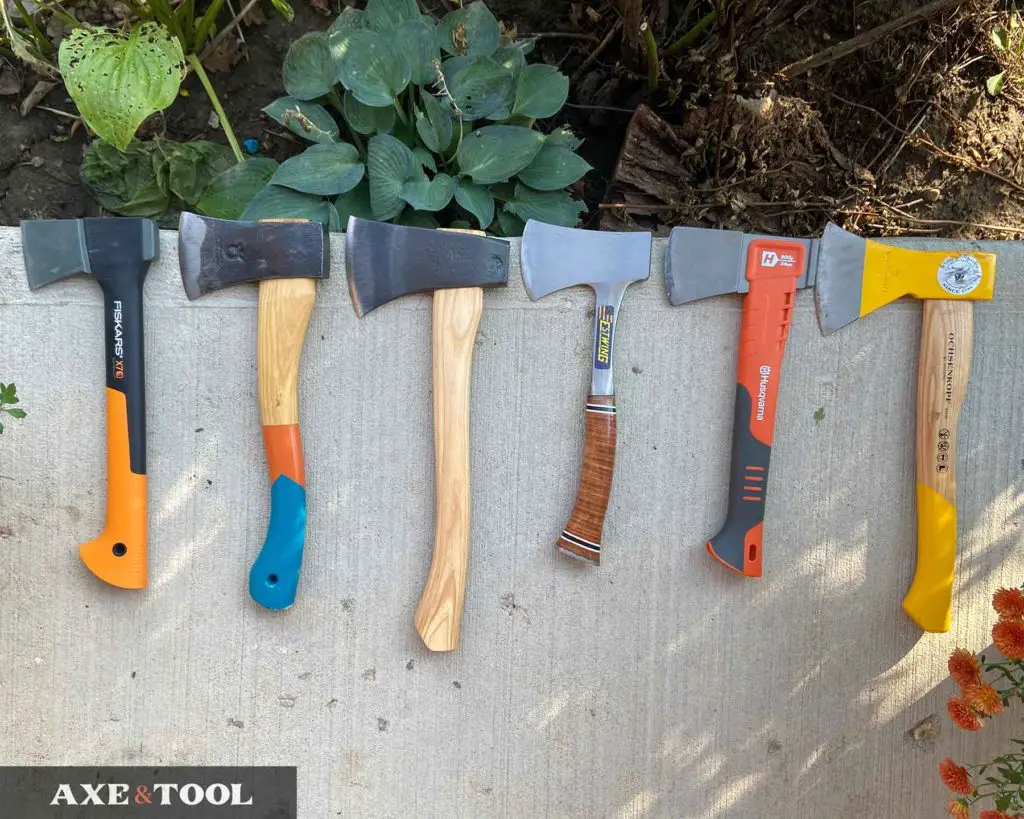
It may surprise you, but yard work can be harder on an axe than tree work.
Hatchets are best suited to standard tasks around the yard (over full-size axes) because they are maneuverable and easy to use high for branches and low for roots.
A “yard work” axe or hatchet should be good quality but priced low enough that you won’t be heartbroken if it takes a beating. You don’t want a cheap off-brand axe, but a high-value axe from a reputable maker.
While I already had a favorite I’ve used for years in my yard – I tested 6 popular hatchets that meet the criteria.
My top choices for yard work hatchets are:
1. Fiskars X7
2. Husqvarna 13″ Wood Axe
3. Council Tool Flying Fox
The reason I recommend Fiskars for yardwork is they are affordable, durable, come sharp, and require almost no maintenance compared to a wood-handled axe. Plus they have a wide range of options.
Hands-on Testing 6 axes
Each axe was evaluated for:
1. Chopping roots & low to the ground
2. Clearing small branches off a tree `
3. Chopping through a 2” branch
4. Maintenance & Care
5. Value
Bonus: Is it a good kindling splitter for the fire pit?
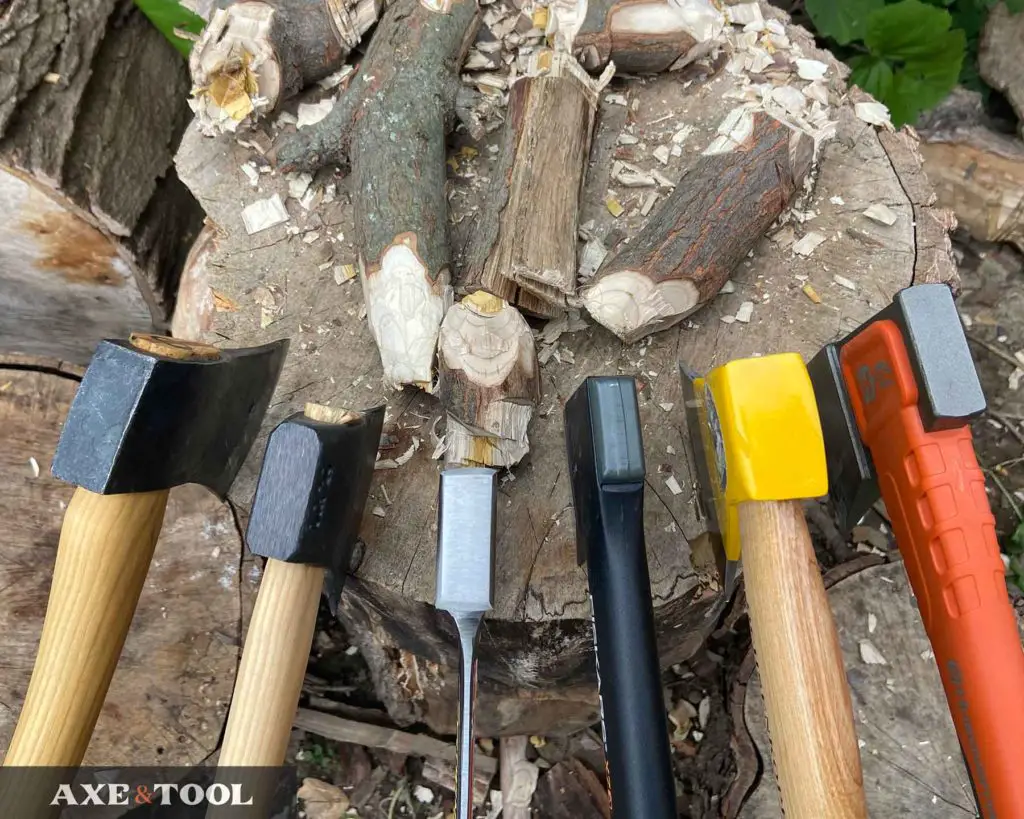
Fiskars axes are great for yard work
I own a lot of axes, and Fiskars has been my go-to axe for work around the yard for 8-9 years.
There are better axes out there (maybe even some in this list) BUT – Fiskars axes work well, they’re affordable, and you don’t need to care about them.
The Fiskars X7 is ideal for small yard work. The stout, flat-topped head can fit in small spaces and chop at roots without hitting the dirt. It’s affordable, comes sharp, and can be stored in a shed or garage year-round. However the X7 is small, so you might consider the X10 for heavy chopping needs.
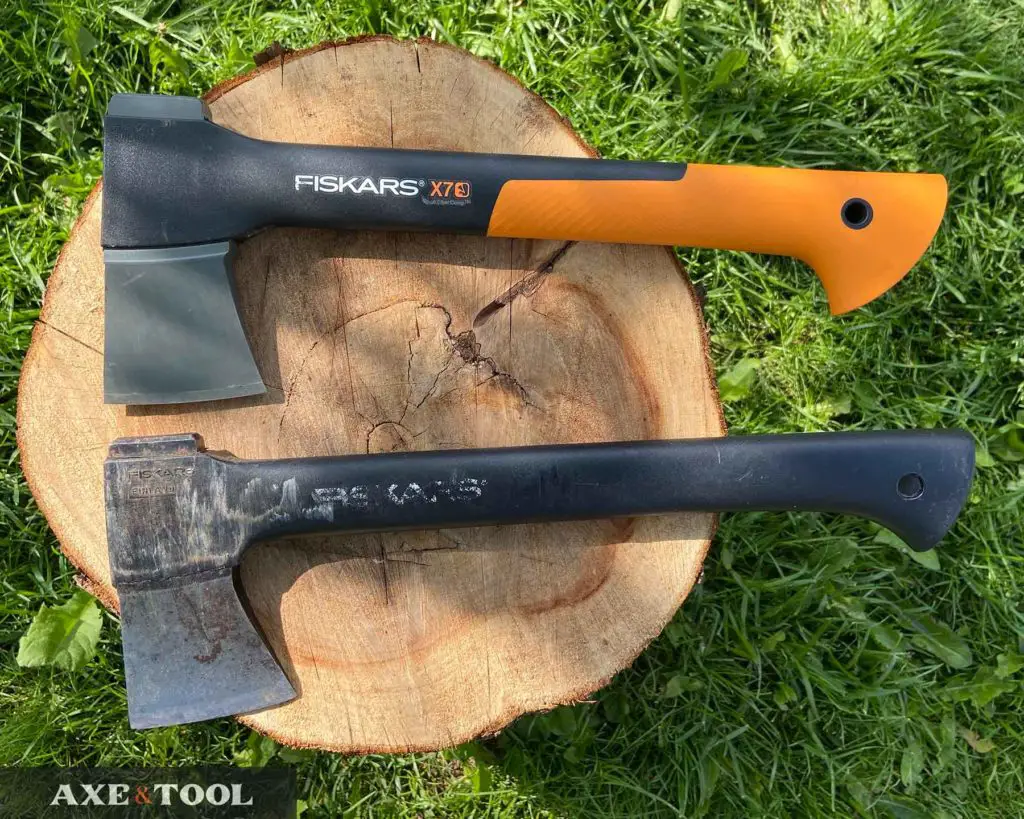
New Fiskars X7 above my long-serving garden hatchet
The Fiskars X7 is perfect for roots and tight spots
The Fiskars X7 head is well designed to chop roots or near the ground. The flat top and a short (2.75in) slightly angled cutting edge allow you to chop with the toe (top corner) and avoid hitting the earth.
The dirt can be incredibly hard on a blade. Moisture in the dirt will penetrate the steel (causing rust) and small hidden rocks and pebbles are just waiting to chip your edge.
If you do hit a rock, the edge might chip and need sharpening. The Fiskars steel is a little softer, and the flat grind edge shape (while sharp) can be a little more brittle. But it’s not hard, and sharpening is a part of all axe work.
I have an article on Fiskars maintenance here.
Fiskars X7 for chopping branches
The Fiskars’ wedge-shaped heads perform really well as a chopper, especially in softwood (which most garden shrubs and trees are). It clears chips and doesn’t get stuck.
It comes with a 30-degree flat grind edge, which is surprisingly sharp for the price, and they do a good job cutting.
In testing: The X7 was one of the quickest for chopping through a 2″ branch. If you are doing a lot of chopping of larger branches than this I would again consider the 17″ axe.
The compact 5-inch head length and short 2.75-inch cutting edge make the X7 a nimble little hatchet. It can chop at individual limbs within a shrub or bush without getting caught up or damaging other branches unintentionally.
The trade-off is that you need to chop at each branch individually. The X7 has a short-cutting edge. Larger blades can clear multiple little branches and twigs at once and be swung with less precision and still catch the branch.
The X10. It has a 17-inch handle that can reach farther and be used one or two-handed. The larger head has a thinner profile, perfect for chopping and clearing branches. It also has a flat top to chop roots but is a little big for really tight work.
In the USA/CAN this axe is marketed as the Gerber Freescape 17.5 (Gerber is owned by Fiskars).

Fiskars are extremely durable
Most people don’t want to have to worry about their garden tools, just use them and put them back.
One of the main reasons that I recommend Fiskars for yard work is that you don’t really need to care about them beyond an occasional sharpening.
Unlike a wood-handled axe, you can store the axe in a garden shed or garage without worrying about any damage happening to the axe.
The composite handle can withstand temperature changes and humidity – the head will never come loose, and the handle won’t weaken.
Fiskars sheaths are perfect for a garden shed
The axe comes with a quick detach plastic holder that is well-vented for storage somewhere like a garage and comes with a slot to be hung on a nail. Which solves the problem of knowing where the hell to put it.
Hanging it on the wall can also help keep it out of little mischievous hands if you have young kids.
Fiskars axes are high-value
You can find the X7 for between $25-$30. Considering crap axes on Amazon go for the same price, these are a great value. And you won’t feel the pain as it gets banged up along the way – you can get a lot of chopping for $30.
Bonus: The X7 is a great kindling splitter
If you have a backyard fire pit the X7 also makes a surprisingly good little kindling splitter. The wedge-shaped bit pops the wood apart.
If you think you need a bigger Fiskars axe check out my article on how to choose the right one – I own them all.
Husqvarna 13” Wood Axe

If you want a traditional wood-handled axe for small yard work, this would be my choice (note: it doesn’t come with the handle painted).
I’ve had this for 3 or 4 years now, and I have been impressed. For a long time, it felt like the only decent-priced traditional hatchet available that was any good.
Chopping roots:
The cutting edge is on the smaller side, but it is curved with a slight flare at the toe so it may not avoid the dirt completely. However, the Swedish steel is harder than any other axe on this list and can withstand more abuse without chipping.
Limbing and chopping branches:
The head is midsize, a little bigger than the Fiskars, but still just suited for individual branches.
It performed very well in the 2” chopping test, busting chips, and no stickiness. It was just as fast as the Fiskars X7.
Husqvarna axe maintenance
Husqvarna axes may need to be sharpened before use to get the best results, as they can the sharpness from the factory is inconsistent. I have had some come sharp(ish) and a couple come dull.
However, once sharp it will need less frequent sharpening, as the Swedish steel is harder than the other axes on this list.
Caring for a wood-handled axe:
Wood-handled axes run the risk of the head coming loose if not cared for or stored properly.
Do not store a wood-handled axe in a shed or a non-climate-controlled garage. Fluctuating temperatures and humidities can damage wood handles and loosen heads. They will expand and shrink with the temperature, crushing and then contracting wood fibers. This will loosen the head, and make your handle feel dry and splintery.
A properly oiled handle can resist these temperature changes better, but It’s best to store the axe indoors. It’s best to do both.
We have a thorough step-by-step guide to oiling your handle that will leave your axe handle feeling like a vintage tool (without the years of hard use).
Husqvarna axes are good value
For around $50, these axes are made with excellent materials and come with a sheath. It’s a good axe for a decent price, and with a little tuning, it can be made even better.
Bonus: A good kindling splitter
Council Tool Flying Fox
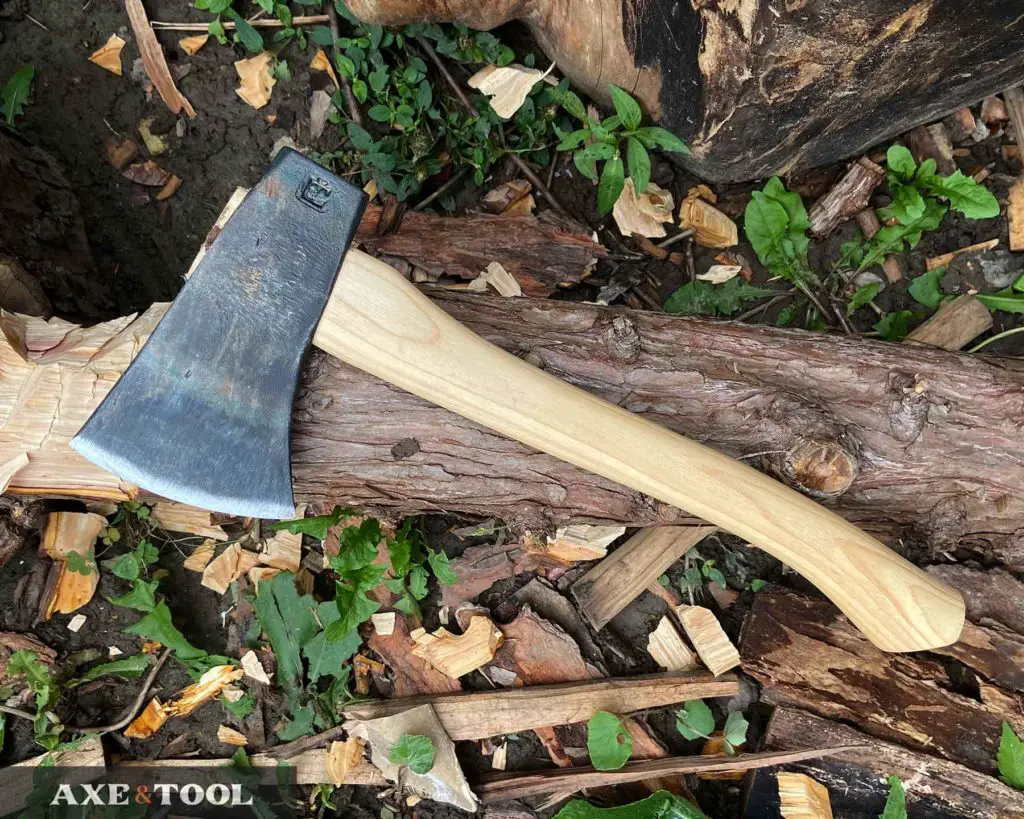
Overall I love this hatchet, and it makes a great value bushcraft axe – but there are a few reasons I don’t pick it as often for yard work.
The flying fox is not designed for rootwork
This axe has a very unique head design. The top flare is small, and it can chop roots pretty close to the toe. So it can stay mostly out of the dirt, but the long cutting edge can get in the way by catching other branches.
The large thin blade is just a little too big for tight work in the bushes.
And even though it’s an affordable axe, I still feel bad putting this one in the dirt.
The flying fox excels at limbing and chopping
The 16″ handle is a little longer than the other axes, and the large thin blade is great for chopping and cutting through branches. With a 4″ blade it has an extra inch of cutting edge on even the larger Fiskars axe.
The blade can catch multiple branches in a single swing and allows you to focus more on power than accuracy. This is helpful if you are swinging at branches above you where it can be a little trickier to aim.
The larger blade and longer handle also make this a great hatchet for chopping through larger branches or trunks. I would take this hatchet in a heartbeat for chopping anything larger than 2″.
However, what surprised me was it didn’t do any better than the Fiskars on the 2″ branch test. That might be because the factory edge was only okay. Nice profile, but not super sharp.
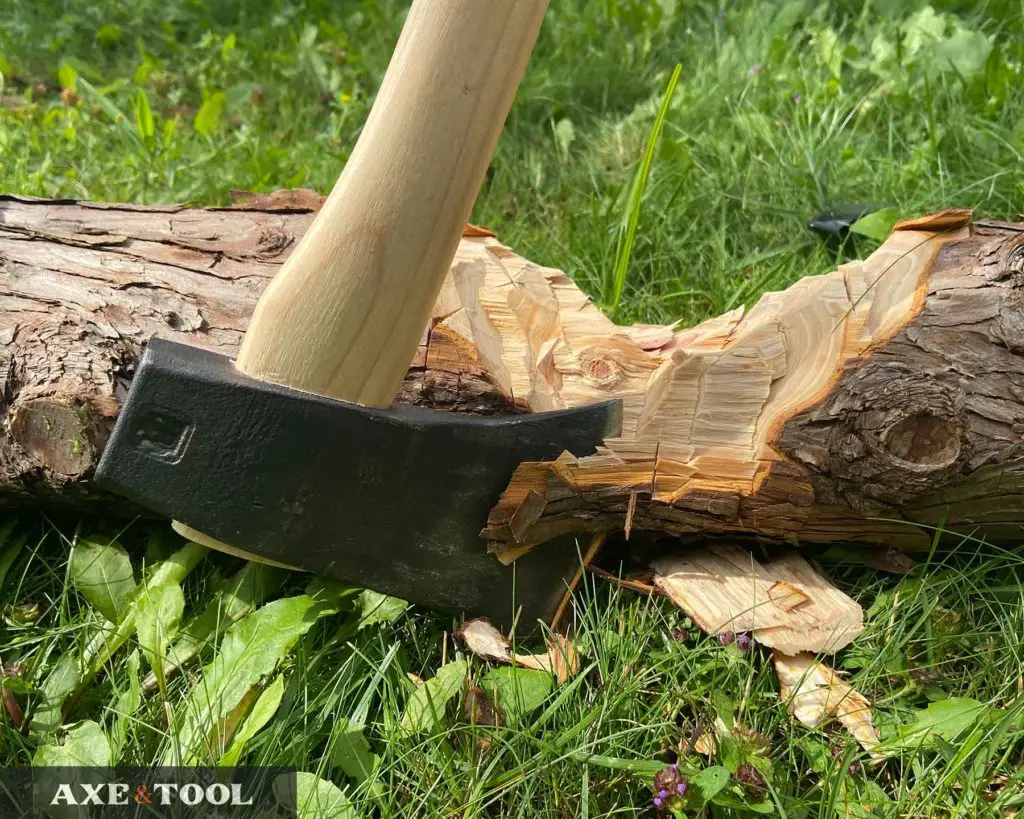
Maintenance
This hatchet has the nicest wood handle of any value axe I have ever bought. It’s thin, with a nice palm swell, and very comfortable. But it should be oiled, possibly sanded like the Husqvarna.
See the section above on how to properly care for a wood handle (click here to jump back).
Bonus features of the flying fox:
Hammer time: This axe has a hardened poll (back of the axe) so unlike most hatchets it can reliably be used as a hammer.
Splitting: Capable but not the best splitter, the blade is long and thin so you need to drive the whole head through before it pops the wood apart.
Husqvarna 13” Composite Axe
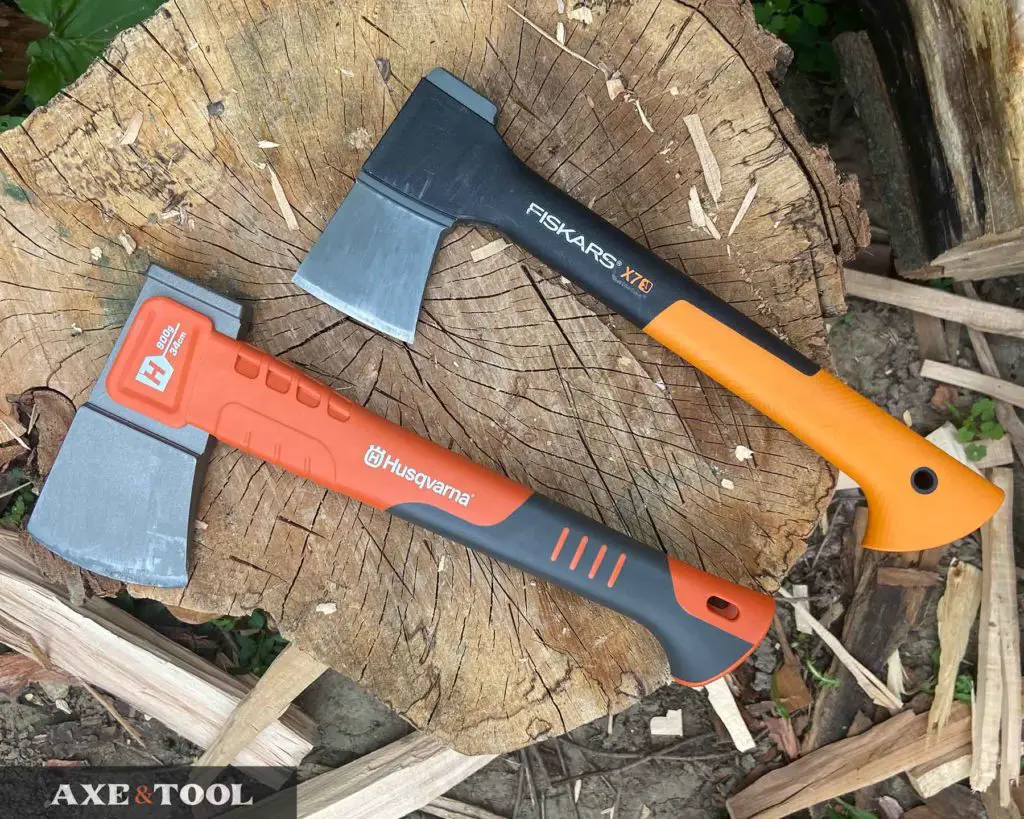
The Husqvarna composite axe is not bad, it’s very similar to the Fiskars in a lot of ways. I just think Fiskars is better for this role.
Husqvarna 13” composite vs Fiskars X7
The Husqvarna has a larger, heavier head that chops well, and is an even more capable splitter. The handle is robust and the head can also double as a hammer (which the Fiskars cannot). But it’s not fit for all tasks.
The edge comes poorly shaped and not sharp. The coating on the head dulls it even more until you have broken it in. The handle is slicker than the Fiskars and not as nimble for fine tasks. It’s great for thumping on, but not fine work.
You can really abuse it if you need to, but you need to sharpen it right away to get the best use. I think the extra weight, and extra work upfront to fix the edge is overkill for a lot of simple yard work.
Also, it costs twice as much.
I would take the light, sharp, nimble Fiskars.
Estwing Sportsman

This is an iconic American all-steel hatchet that has a long track record as a great affordable little axe. But to be honest – I don’t like them.
Cutting roots with the Estwing
The blade shape is similar to the Husqvarna but much thinner and with a more pronounced curve. So it’s an okay chopper of roots – but you will put the flared toe into the dirt.
Because of the all-steel construction, it’s also not very comfortable to choke up on and hold right under the head if you need to do any fine work. There is also a point at the bottom of the handle which annoys me.
Limbing & Chopping
The curved thin blade is well suited to limbing, but it will need to be sharpened. Estwing axes in my experience come with a great profile, but pretty dull cutting edge. The blade is wide enough to catch multiple smaller branches at once, and the thin flared design is perfect for running flat against the trunk.
The Estwing did fine in the 2” chopping test, but was a little slower. I found it a bit “stickier” than some of the wider profiled edges. Thin blades can get pinched in the wood. It wasn’t a big deal, just something I noticed a couple of times.
Maintenance
Like I said, right out of the box I think it needs to be sharpened. Otherwise, there are just extra considerations with an all-steel axe (and leather handle).
What’s nice is the head will never loosen, but If it gets covered in dirt the whole handle can rust. So you just need to do some basic cleaning and it should keep going for years, if not decades.
Splitting: Capable but not the best splitter, the head only flares out at the very back so you need to drive the whole head through before it pops the wood apart.
“German Style” hatchets (Ochsenkopf / Prandi / Amazon)
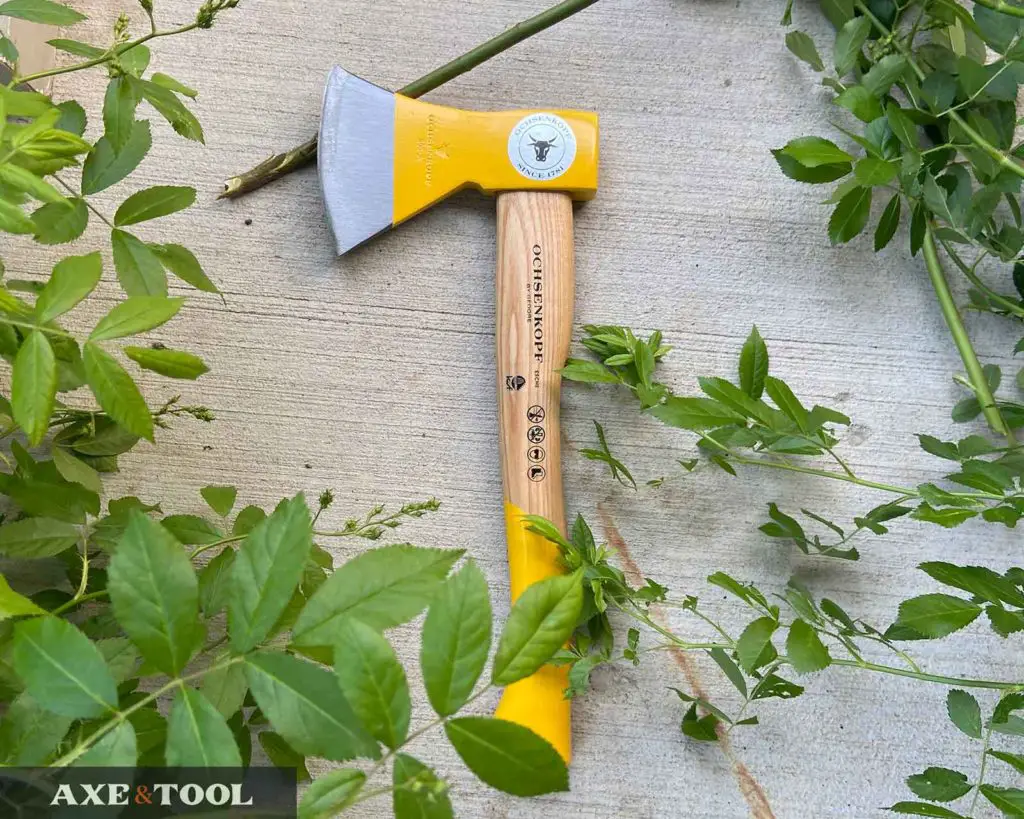
I tested an Ochsenkopf (which is German), but Prandi is another decent low-cost brand. But a lot of cheapo axes on Amazon also use this Rhineland pattern design.
I would avoid this axe pattern as a general yardwork axe. It can work very well in specific roles, but terribly in others.
Poor choice for roots:
This style of axe is terrible for roots, or just close to the ground in general. The Rhineland pattern has a large curved cutting edge, (this one is 4.5”) that flares out in both directions. As a result, you can’t cut at a root without putting part of your blade in the dirt.
Designed to limb and chop:
Of course, that thin 4.5″ blade can catch a lot of branches at once and has all the benefits I mentioned for the Council Tool Flying Fox. I prefer the pattern of the Flying Fox, but that is based on my experience and comfort. This pattern has a long history, I personally just don’t use it well.
Like most axes in this price point, this axe needs to be properly sharpened to truly splice through so many branches. As it comes from the factory it’s not going to do a great job.
As a result, it also performed quite poorly in the chopping test. Partly because it was chopping on a surface, but it just came dull. It was over 40 swings to get through.
Splitting: Not a good choice for splitting kindling
Please comment below If I missed something or if you have any questions. I do my best to respond to everyone.
About the author:
About the author:
Jim Bell | Site Creator
I’m just a guy who likes axes. I got tired of only finding crap websites, so I set out to build a better one myself.
I’m also on Instagram: @axeandtool


I’d like to get my daughter a gardening hatchet for her birthday and to somewhat memorialize the childhood memory of my mom chopping roots as she designed her gardens with minimal resources.
She bought the little hatchet with her carefully saved S & H green stamps. You look too young to have any recollection of these but your grandparents would likely be familiar.
I was looking at a Swiss stainless steel hand hatchet on an online site that was $179 but after reading your information I feel confident that I can get an adequate hatchet for root cutting at a fraction of the price.
Thanks for the information.
Bought th Council Flying Fox based on another article in your site. Received it and promptly limbed a magnolia after highwind rainstorm. “The flying fox excels at limbing and chopping” — you are spot-on! I was so impressed and this th only yard work task I have planned for th FFox! Another bit of good news for a new buyer is that it comes with an unvarnished handle. Go straight to th oiling/waxing phase — skip th scraping-off-hard-finish step! Woohoo… Excellent axe 🪓 based on your great advice. Thanks Jim… m
Awesome glad it’s working out! Always appreciate getting other people’s hands-on opinions to back up the articles or make me re-examine things. Thanks for another great comment Mark (you are popping up everywhere lol)